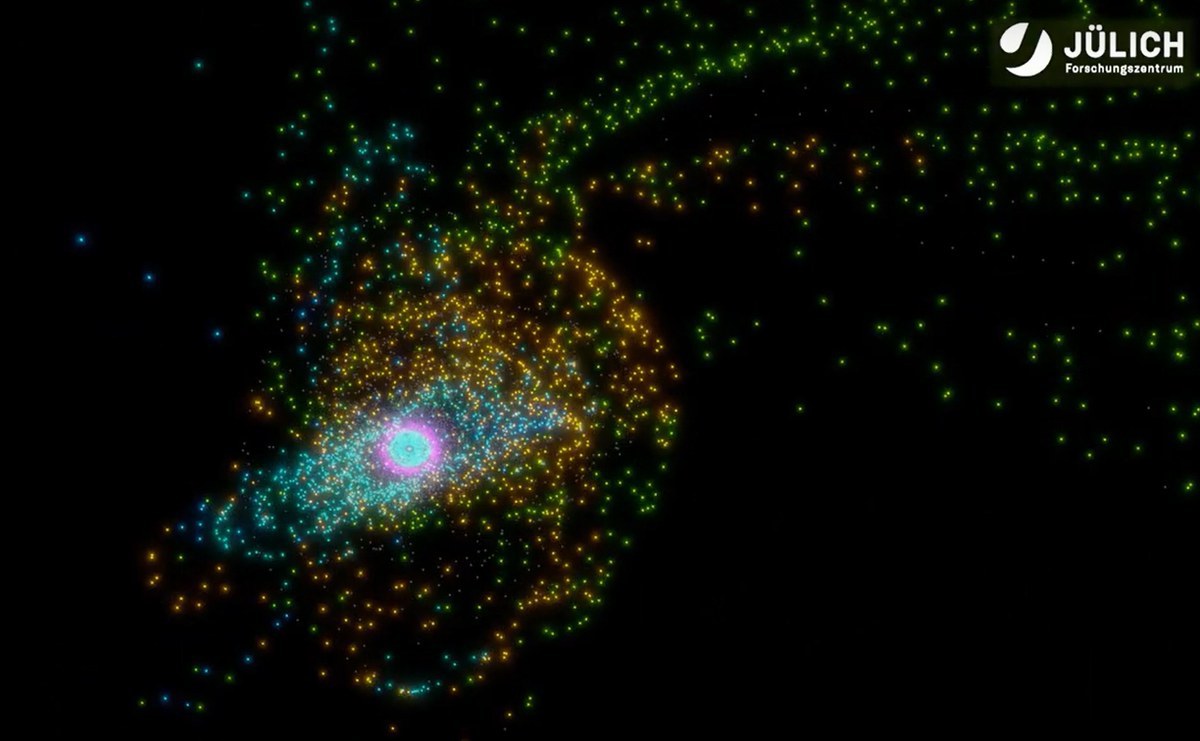Flyby of a star explains dynamics of the solar system beyond Neptune
New findings suggest that billions of years ago, a star may have passed so close to our solar system that thousands of smaller celestial bodies changed their trajectory: Travelling in the outer solar system outside Neptune's orbit, they drifted into highly inclined orbits around the sun. It is possible that some of them were catapulted towards the sun and captured as moons by Jupiter and Saturn. This was discovered by a team of astrophysicists from the Jülich Supercomputing Centre (JSC) and Leiden University in the Netherlands using computer simulations. The two studies were recently published in the renowned journals Nature Astronomy and Astrophysical Journal Letters.
When we think of our solar system, we usually assume that it ends at the outermost known planet - Neptune. However, astrophysicist Prof Susanne Pfalzer (JSC) explains: "Several thousand celestial bodies are known to move beyond the orbit of Neptune." There are even thought to be tens of thousands of objects with a diameter of more than 100 kilometres. "Surprisingly, many of these so-called trans-Neptunian objects move on eccentric orbits that are inclined relative to the common orbital plane of the planets in the solar system." A mystery that has so far remained unsolved.

Together with Amith Govind (JSC) and Prof Simon Portegies Zwart (Leiden University), Susanne Pfalzner has used more than 3000 computer simulations to investigate a possible cause of the unusual orbits: Could another star have caused the strange orbits of trans-Neptunian objects?

The astrophysicists found that a single striking, close flyby of another star can actually explain the inclined and eccentric orbits of the known transneptunian celestial bodies. "Even the orbits of very distant objects can be deduced, such as that of the dwarf planet Sedna in the outermost reaches of the solar system, which was discovered in 2003. And also objects that move in orbits almost perpendicular to the planetary orbits," explains Pfalzner. Such a flyby can also explain the orbits of 2008 KV42 and 2011 KT19 - the two celestial bodies that move in the opposite direction to the planets.
"The best match for today's outer solar system that we found with our simulations is a star that was slightly lighter than our Sun - about 0.8 solar masses," explains Amith Govind. "This star flew past our sun at a distance of about 16.5 billion kilometres. That's about 110 times the distance between Earth and the Sun, a little less than four times the distance of the outermost planet Neptune."
The realisation that the flyby of an alien star billions of years ago could also provide a natural explanation for closer phenomena was the most surprising for the scientists. When Susanne Pfalzner, Amith Govind and Frank Wagner (also JSC) investigated more closely, they observed how some of the trans-Neptunian objects were hurled into our solar system - into the region of the outer giant planets Jupiter, Saturn, Uranus and Neptune.

"Some of these objects could have been captured as moons by the giant planets," says Simon Portegies Zwart. "This would explain why the outer planets of our solar system have two different types of moons." In contrast to the regular moons, which orbit close to the planet on circular orbits, the irregular moons orbit the planet at a greater distance on inclined, elongated orbits. Until now, there was no explanation for this phenomenon. "The beauty of this model lies in its simplicity," says Pfalzner. "It answers several open questions about our solar system with just one single cause."
Original publications:
“Trajectory of the Stellar Flyby Shaping the Outer Solar System” (Nature Astronomy)
DOI: 10.1038/s41550-024-02349-x
and “Irregular moons possibly injected from the outer solar system by a stellar flyby (Astrophysical Journal Letters)”
DOI: 10.3847/2041-8213/ad63a6
Video: Scientists at the Simulation and Data Lab Astronomy and Astrophysics at Forschungszentrum Jülich have carried out more than 3,000 computer simulations to find the cause of the unusual orbits of the transneptum objects. The young sun is surrounded by a disc of the material from which the planets eventually formed. There are several indications that the close flyby of another star could have disturbed this disc. The simulation shows how such a close flyby would have strongly influenced the orbits of the outer disc material. Many objects would have been thrown far out into space on eccentric orbits. While the outer solar system would have been completely restructured, the inner solar system, including our Earth, would have remained undisturbed.
Contact:
Amith Govind, JSC
See also the corresponding Press Release of the FZJ.

